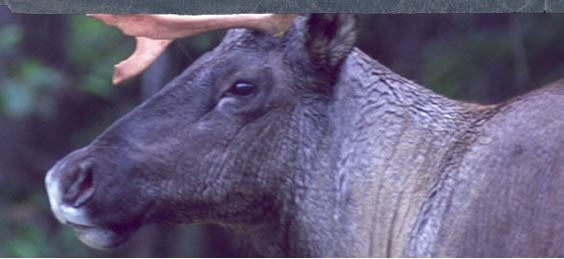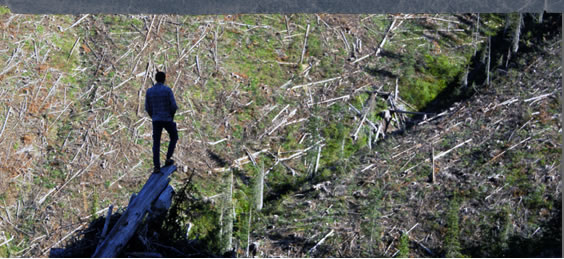Mountain caribou make up the southernmost occurrence of caribou in the world. Other kinds of caribou include the barren-ground caribou of Canada's far north, and several kinds of reindeer in Europe and Asia.
Superbly adapted for snow and cold with their large hooves and insulating coat, caribou would have been among the first animals to return to this part of the world at the end of the last Ice Age, around 9,000 years ago. Their numbers declined here after the completion of the Canadian Pacific Railway made hunting them for market possible. Conservation measures introduced in the 1930s placed limits on caribou hunting, but their numbers never fully recovered. Hunting caribou in the Columbia region ceased entirely in 1996.
Since the 1970s, hydro-electric reservoirs and logging have reduced low elevation old growth forest habitat. The scattered remaining bits of habitat take more energy for caribou to access and traveling exposes them to more hazards. Accidents with avalanches and terrain features where the leading cases of mortality among radio-collared caribou in a seven year study in the 1990s.
The past decade has also seen a rapid expansion of snowmobiling and helicopter skiing in the subalpine zone, increasing the disturbance in caribou's late winter habitat. Research results from radio-collared caribou indicate that accidents, particularly avalanches, are the main cause of mortality.
In an effort to manage resources on an ecosystem basis, Parks Canada has participated in caribou research and monitoring projects with provincial agencies since 1992.
Caribou are unique in the deer family in that both females and males grow antlers. Mountain caribou are larger than deer and smaller than elk, with males weighing approximately 175 kg. Their hollow fur insulates them through the long mountain winters.
When snow falls in early winter, mountain caribou are found in low elevation old-growth cedar and hemlock forests where trees may exceed 1000 years in age. Here, they feed on ground plants such as falsebox. Once the mid-winter snow buries those foods, caribou move higher into sub-alpine spruce/fir forests where their dinner-plate-sized feet act like snowshoes, allowing them to use the deep winter snow as a platform to reach lichens draped from old-growth trees. These tree lichens are typically the only food source for caribou form most of the winter, and are found in abundance only in old-growth forests.
The critical winter range of mountain caribou overlaps considerably with backcountry recreation activities such as helicopter skiing, snow-cat skiing, and snowmobiling. Technological advances and unregulated access has led to more and more people spending their winter play time in endangered mountain caribou habitat. Commercial recreation enterprises have unprecedented access to BC's wilderness. This adds additional stress to an animal that is already being squeezed by habitat fragmentation, at a time of the year when it is most vulnerable because of the increased energy demands of winter.
BC's back-country recreation industries are not required to meet with clear, enforceable standards, the BC government has relied on voluntary "best management practices" to reduce impacts to caribou. Additionally, the BC government continues to grant helicopter ski tenures, as recently as December 2005, in critical winter mountain caribou habitat, despite protests from independent and government biologists.
Scientists agree that climate change is already affecting British Columbia's ecosystems, and we can expect such change to continue. It is harder to predict the exact nature of those changes, and how they will affect us. Most scientists believe temperatures will continue to rise. Winter snow-packs in the inland temperate rainforest are already decreasing, and this decrease will probably continue. This is a potential problem for caribou, which rely on deep snow to be able to reach lichen, their main winter food.
We know that healthy forests, such as old-growth, are better able to withstand and adapt to change. Because logging releases the carbon that is contained in forests, the Union of Concerned Scientists recommends forest conservation as its top forest-based strategy for mitigating global warming. (Union of Concerned Scientists)
All animals need healthy habitats that allow them to move across the landscape when they need to. Caribou have weathered a number of climate change events over the last several thousand years. If enough forests are protected, and habitat remains connected, the outlook for caribou and many other species including humans will be much brighter.
WHO IS LOGGING MOUNTAIN CARIBOU HABITAT?
Logging continues to have severe impact on the Mountain Caribou. Habitat alteration disrupts the conditions under which mountain caribou, and other species including predators, have co-evolved.
Clear-cuts attract deer, elk and moose, because for a few years after logging there is more food for them (low shrubs and herbs). This allows these animals and their predators to increase and expand into mountain caribou habitat.
Historically, it was not energy efficient for predators to rely on caribou as a main food source, since caribou spread themselves throughout the forest at relatively low densities. But as the ranges of deer and moose increase, predators are encountering and killing -- caribou more frequently.
*The above table is from Staring At Extinction published in May 2005. More recent analysis (December 2005) showed West Fraser to have 33,553 ha of planned cut-blocks in mountain caribou range. Tembec Inc. is theoretically 5th in area with 2,775 ha of cut-blocks approved, but the company has agreed to moratoria on all cut-blocks within mountain caribou habitat except where mountain pine beetle infestation is extensive, and to not build roads anywhere in mountain caribou habitat.
Recent large-scale outbreaks of mountain pine and spruce bark beetles in many areas of BC have prompted aggressive logging activities. in many forest stands, including critical mountain caribou habitat, the war against beetles involves use of clear-cut, selection, and salvage logging, as well as the construction of new roads. This puts added pressure on mountain caribou: lichen-bearing trees are lost, other ungulates ad their predators are drawn to new cut-blocks and roads, and increased access is created for backcountry recreationists.




